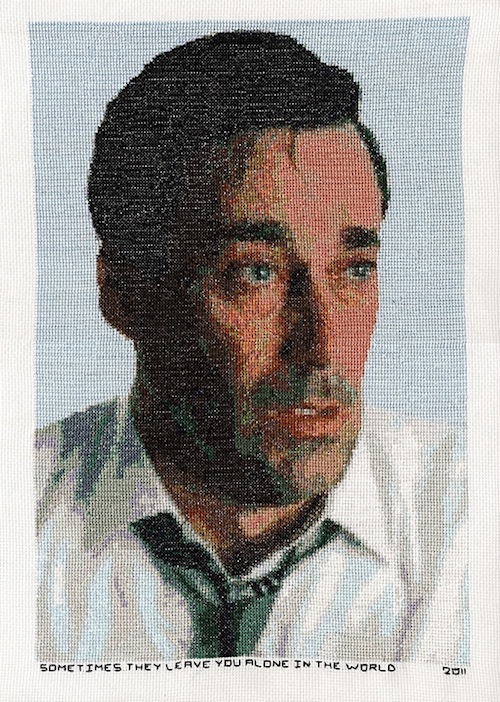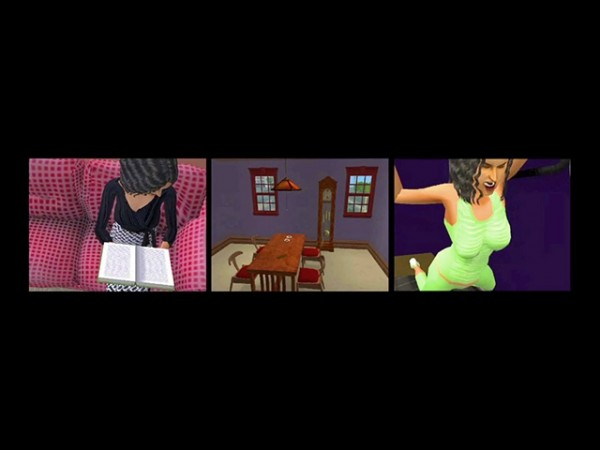
Stacia Yeapanis. “Don Draper,” 2011. Handmade cross-stitch embroidery. 14 x 10 in. Courtesy the artist.
When Stacia Yeapanis finished graduate school at the School of the Art Institute of Chicago in 2006, she did what many MFA grads do: moved her studio into her home. But soon thereafter Yeapanis found herself overwhelmed by an inability to separate her art practice from other areas of her life. Instead of fretting about it, she applied for the Chicago Artist Coalition’s first ever BOLT Residency, a program begun in 2011 to help local artists make solid, professional inroads in their practice.*
Yeapanis explores the emotional and existential experience of repetition in our daily lives. For instance, in her project My Life as a Sim (2005–2007), she mused on the idea of “winning” in a virtual reality that positioned life as a game. And in her series Everybody Hurts (2004–ongoing), she captures moments of heightened emotion in television shows, meticulously, obsessively, and meditatively creating cross stitches of them until what was fleeting becomes embroidered in time. She confronts and then transforms these moments in mass media into something nearly spiritual. Embracing emptiness in mediated culture, Yeapanis’s work transcends humdrum acts to create meaningful experiences out of what are otherwise empty signifiers.
Before starting the BOLT Residency, Yeapanis departed from video and cross stitching, transitioning into collage, though retaining the thread of remix culture already observable in her practice. In the following interview, Yeapanis and I discuss the process of applying for BOLT, how it changed her work, and why it’s essential for artists to do residencies both locally and nationally.

Stacia Yeapanis. “Life isn’t bliss. Life is just this. It’s living,” 2007. Video still. Courtesy the artist.
Alicia Eler: You participated in the BOLT Residency during its first year—what was that like?
Stacia Yeapanis: The program consists of a communal studio space in the basement of the Chicago Artists’ Coalition (there are nine studios) and offers studio visits with Chicago arts professionals, like curators, writers, other artists, and teachers. Although it doesn’t start immediately, you are getting to meet with these people at least once a month, maybe more, so you have at least twelve studio visits. Everyone gets a solo exhibition in the BOLT project space upstairs, so you’re preparing for that throughout the year.
AE: What are some of your most notable exhibitions thus far?
SY: I’ve shown at the Museum of Contemporary Photography Chicago, where I was part of a three-person show, with Curtis Mann and John Opera, a couple of years ago. I’ve had a lot of group shows, mostly in Chicago, but I was also in a wonderful exhibition called Losing Yourself in the Twenty-First Century, which was in Atlanta and Maryland. It was an all-female show. It wasn’t defined as a feminist show, but it was definitely about what female artists working in a particular media were doing at that moment. Although, I would say that I’m an emerging artist.
AE: What was your work like when you first applied for the residency and how did it change over the year of being there?
SY: Although I do feel like I just made a new leap, I wouldn’t say that I’m making drastically different work than I was at the beginning. I tend to work with long-term projects and I do a couple of them at once. I tend to make slow progress on each of them because I’m doing different things at the same time.
The wall-based collage work I’m doing is all cut from magazines. It’s a lot of big amorphous images and it uses a lot of repetition, examining what images pop up over and over again in ads–looking towards abstraction but also trying to talk about the excess and the void in relation to mass media images.
I was working on those collages for a year before BOLT. One of the reasons I applied was that I was running out of wall space in my apartment and couldn’t let the collages grow as big as I wanted. I had the collages all over and it was intense; I was taping them and they were all over the floor. It was sort of a simmering year, and that’s when I decided I needed to get wall space. I knew I needed to get out of my apartment…BOLT allowed me the opportunity to let the work expand in a way it simply couldn’t before. And then, over the course of the year, I continued to work on the collages, but I didn’t solve the problem of the collages. What I did do was shift gears. For so long, the way I’ve thought about my work is that there are underlying ideas in all these different media that I work in.

Stacia Yeapanis. “I Still Haven’t Found What I’m Looking For,” 2012. Found magazines and T-pins. 48 x 43 in. Photo: Helen Maureen Cooper
Whenever I show the cross stitches together or just the video, I can’t get people to see what’s connecting them, and that’s something I care about. The strategy in the cross stitch is the same as the strategy in the remix video, and it’s the same strategy in the collage. I don’t like the idea that the digital and the handmade are somehow separated. Humanness exists everywhere, whether you are touching something or you are in the digital world. That’s something I wanted to pull out in my solo show. I wanted to do an interdisciplinary show and exhibit something I make in every type of media. I wanted to try to get the audience to consider it all together, instead of just as a collage.
I went to BOLT intending to have a collage show, but through the conversations about my work and the studio visits, I realized I had total control of my work at BOLT and I wasn’t always going to have that. I had a space right upstairs that I could sit in and think about how I wanted to put work in it. That’s pretty unique. I could just walk upstairs and sit in the exhibition space and imagine how I wanted my work to look in that space. So, I switched gears and decided I wanted to do an interdisciplinary show. It included the collages, but I also included things like a handmade paper sculpture that’s very abstract. I built pieces that I had been thinking about, but that didn’t fit with any of my other work, and that I’d been putting off. For example, there was a column of silverware—I’d wanted to make that piece forever—I saw its connection to this process but it wasn’t in a body of work.
I created a body of work that I thought went together, even though it was a lot of disparate media. I was really pleased with it. I had to do that to move on…

Stacia Yeapanis. “All We Are is Dust in the Wind” and “Black Hole” with clock from the series “Over and Over Again,” (2012). Installation shot. Courtesy the artist.
AE: So it gave you new confidence, and you could say, “I am a Chicago artist and I am doing this”?
SY: Yes. The most important thing that I heard last year was that an important curator at an important art center had seen my cross stitches and really liked my work, but felt like it was being shown a lot. [That person] held on to my stuff, and I didn’t really know what that meant. But it made me relax a little and think to myself, “Okay, they liked that work. They felt like it was being shown too much. That’s kind of awesome…and that means they’re going to wait and see what you do next.” I realized that I can just keep doing what I’m doing. I can’t control if someone is really into it or not, but it doesn’t mean no one’s noticing if I’m not selling a ton. I’m more interested in the slow burn anyway, and the residency has allowed me to plant a ton of seeds. There are so many people that I had access to and now know–I would feel comfortable going up to talk to them. I’ve had good conversations with people. I know who was or wasn’t interested in my work, and if I make something new that I think one of them will like, I don’t feel like it would be crazy for me to email and ask for feedback. I never would have emailed a curator who I didn’t know…but I now have a point of contact and a relationship.
___________________
*Another aspect of BOLT is their exchange program. For Exchange: Chicago<>Detroit, which opened earlier this year, BOLT residents exhibited work at Public Pool in Detroit and Detroit artists exhibited work at the Chicago Artists’ Coalition. Each year BOLT connects with a different city. Their 2013 residents will travel to Minneapolis for an exchange with the Soap Factory.
Stacia Yeapanis is a Chicago-based interdisciplinary artist and a member of Henbane Collective. She holds BA in German from Oberlin College and an MFA in Studio Art from The School of the Art Institute of Chicago. Her work is included in both the rotating Midwest Photographers Collection and the permanent collection at the Museum of Contemporary Photography, as well as various private collections. In May 2013, Yeapanis will create a wall collage for Abstracting the Seam, curated by Allison Peters Quinn at Hyde Park Art Center.
Alicia Eler is Art21’s February blogger-in-residence. Previously, she has written about Yeapanis for Time Out Chicago and Artforum.com. Alicia’s interview for Art21 was transcribed by Claire Potter.



